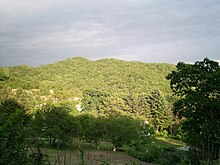Wildlife of Russia
The wildlife of Russia inhabits terrain that extends across 12 time zones and from the tundra region in the far north to the Caucasus Mountains and prairies in the south, including temperate forests which cover 70% of the country. Russia's forests comprise 22% of the forest in the world[1] as well as 33% of all temperate forest.[2]
According to the data furnished in the
Geography
Geographically, the tundra habitat lies in a zone extending from the northern coast 60 to 420 kilometres (37 to 260 mi) to the south; this gradually transforms into the extensive and dense forests of the

The tundra region is entirely within the
Russian wildlife has been categorized by
Legal framework
The Forest Legislation 1993 of the Russian Federation is the basic legal framework for forest management. The principle under this legislation underlines the federal status of forests in enforcing compliance by all forest users and governs the use of the forest stock, states the rules of forestry, reproduction, conservation and protection of forests and other norms and rules. The management of the Forest Fund is the responsibility of the Federal Forest Service, further delegated to the forest management districts.[12]
The Game Department's rules are based on the Law on Protection and Use of Wildlife 1982, which defines game species on all lands, except the designated protected areas such as the zaponvedniks. The 250 animal species and 500 plant species listed in Russia's Red Book (as of 1984) are under the jurisdiction of the Ministry of Environmental Protection and Natural Resources (MEPNR), which is being updated. Non-game species are not included under legal protection.[13]
A new draft of the forest code, which is a part of Russian law, governs the sale of the forest to private companies. Leasing of forests to private shows/firms regulated by the central government is given for a period up to 49 years.[1]
Flora and funga
The ice fields of tundra are covered on the top by lichens, mosses, grasses and flowers, which for nine months are buried under snow. There are only a few trees and bushes here which are in a twisted dwarfed condition as their roots can not penetrate the permafrost.[5] The taiga forest is densely populated with spruces, firs, pines and larch. On the forest floors grass, moss, lichen, berries and mushrooms are reported.[6] The steppe consists of croplands and grass lands. In the Volga Delta, Caspian lotus flowers in pink and white spread across the water during the summer.[6] The Caucasus region has 6,000 plant species of various types including wild flowers.[7] In Ussuriland, there exists a lush monsoon forest quite different from the taiga forest, and in this, the trees and undergrowth are draped with lianas and vines.[8]
Fauna

Due to extreme weather conditions, wildlife in the tundra is limited.
References
- ^ a b c d "It's Europe's lungs and home to many rare species. But to Russia it's £100bn of wood". The Guardian. Retrieved 28 November 2015.
- ^ "Russia". U.S. Fish and Wildlife Service. Retrieved 28 November 2015.
- ^ "The list of animals for Red Data Book of Russian Federation (1 November 1997)". A Centre for Collaborating with UNDP. Archived from the original on 28 April 2016. Retrieved 28 November 2015.
- ^ Slaght, Jonathan; Maher, Julie Larsen (5 September 2015). "The Rare and Exotic Animals of Russia's Far East (Photos)". Livescience.com. Retrieved 28 November 2015.
- ^ a b c d e Richmond 2010, p. 115.
- ^ a b c d e f Richmond 2010, pp. 115–16.
- ^ a b c Richmond 2010, p. 116.
- ^ a b c d Richmond 2010, p. 117.
- ^ a b Richmond 2010, pp. 117–18.
- ^ a b "Wild Russia Tour". Centre for Russian Nature Conservation. Retrieved 28 November 2015.
- ^ "Welcome to Russia". Centre for Russian Nature Conservation. Retrieved 28 November 2015.
- ^ World Bank 1997, p. 112.
- ^ World Bank 1997, p. 246.
- ^ Slaght, J. C., D. G. Miquelle, I. G. Nikolaev, J. M. Goodrich, E. N. Smirnov, K. Traylor-Holzer, S. Christie, T. Arjanova, J. L. D. Smith, Karanth, K. U. (2005). "Chapter 6. Who's king of the beasts? Historical and recent body weights of wild and captive Amur tigers, with comparisons to other subspecies". Pages 25–35 in: Miquelle, D.G., Smirnov, E.N., Goodrich, J.M. (Eds.) Tigers in Sikhote-Alin Zapovednik: Ecology and Conservation. PSP, Vladivostok, Russia (in Russian)
- Worldwide Fund for Nature. 2015. Retrieved 22 December 2015.
Bibliography
- Russia: Forest Policy During Transition. World Bank Publications. 1 January 1997. p. 246. ISBN 978-0-8213-3896-4.
- Richmond, Simon (15 September 2010). Russia. Lonely Planet. ISBN 978-1-74220-373-7.






